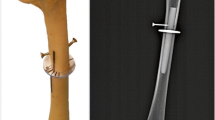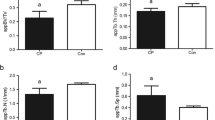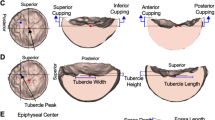Abstract
Summary
Magnetic resonance imaging was used to show that children with quadriplegic cerebral palsy and unable to ambulate independently compared to typically developing children have a remarkably underdeveloped femoral midshaft as indicated by a very thin diameter, a very thin cortical wall, and very low strength estimates.
Introduction
The femoral shaft is very susceptible to fracture in children with quadriplegic cerebral palsy (QCP); however, its structure and strength have not been evaluated.
Methods
The volume and width of the middle third of the femur (midfemur) and its cortical wall and medullary cavity were assessed in children with QCP and unable to ambulate independently and typically developing children (n = 10/group) using magnetic resonance imaging (MRI). Estimates of cross-sectional moment of inertia (CSMI), section modulus (Z), and polar moment of inertia (J) were also determined.
Results
Total volume of the midfemur and volume of its cortical wall and medullary cavity were substantially lower in children with QCP than controls (51–55%; p < 0.001). In addition, the total midfemur, its medullary cavity and the anterior, posterior, and lateral sections of its cortical wall were thinner (27–43%) in children with QCP (p < 0.001). The midfemur in children with QCP also had remarkably lower CSMI, Z, and J (60–71%; p < 0.001).
Conclusions
Children with QCP who lack the ability to ambulate independently have midfemurs that are very thin with very thin cortical walls and very low estimated strength. The disparity can be detected using MRI.



Similar content being viewed by others
References
McIvor WC, Samilson RL (1966) Fractures in patients with cerebral palsy. J Bone Joint Surg Am 48:858–866
Presedo A, Dabney KW, Miller F (2007) Fractures in patients with cerebral palsy. J Pediatr Orthop 27:147–153
Henderson RC, Lark RK, Gurka MJ, Worley G, Fung EB, Conaway M, Stallings VA, Stevenson RD (2002) Bone density and metabolism in children and adolescents with moderate to severe cerebral palsy. Pediatrics 110:e5
Modlesky CM, Subramanian P, Miller F (2008) Underdeveloped trabecular bone microarchitecture is detected in children with cerebral palsy using high-resolution magnetic resonance imaging. Osteoporos Int 19:169–176
Ciarelli TE, Fyhrie DP, Schaffler MB, Goldstein SA (2000) Variations in three-dimensional cancellous bone architecture of the proximal femur in female hip fractures and in controls. J Bone Miner Res 15:32–40
Kleerekoper M, Villanueva AR, Stanciu J, Rao DS, Parfitt AM (1985) The role of three-dimensional trabecular microstructure in the pathogenesis of vertebral compression fractures. Calcif Tissue Int 37:594–597
Majumdar S, Link TM, Augat P, Lin JC, Newitt D, Lane NE, Genant HK (1999) Trabecular bone architecture in the distal radius using magnetic resonance imaging in subjects with fractures of the proximal femur. Osteoporos Int 10:231–239
Ott SM (1993) When bone mass fails to predict bone failure. Calcif Tissue Int 53(Suppl 1):S7–S13
Ferretti JL, Capozza RF, Zanchetta JR (1996) Mechanical validation of a tomographic (pQCT) index for noninvasive estimation of rat femur bending strength. Bone 18:97–102
Dempster DW (2000) The contribution of trabecular architecture to cancellous bone quality [editorial]. J Bone Miner Res 15:20–23
Link TM, Majumdar S, Augat P, Lin JC, Newitt D, Lu Y, Lane NE, Genant HK (1998) In vivo high resolution MRI of the calcaneus: differences in trabecular structure in osteoporosis patients. J Bone Miner Res 13:1175–1182
Parfitt AM (1987) Trabecular bone architecture in the pathogenesis and prevention of fracture. Am J Med 82:68–72
Siffert RS, Luo GM, Cowin SC, Kaufman JJ (1996) Dynamic relationships of trabecular bone density, architecture, and strength in a computational model of osteopenia. Bone 18:197–206
Woodhead HJ, Kemp AF, Blimkie CJR, Briody JN, Duncan CS, Thompson M, Lam A, Howman-Giles R, Cowell CT (2001) Measurement of midfemoral shaft geometry: repeatability and accuracy using magnetic resonance imaging and dual-energy X-ray absorptiometry. J Bone Miner Res 16:2251–2259
Bouxsein ML, Myburgh KH, van der Meulen MCH, Lindenberger E, Marcus R (1994) Age-related differences in cross-sectional geometry of the forearm bones in healthy women. Calcif Tissue Int 54:113–118
Jee D, Gilsanz V, Wren TA (2007) Limitations of peripheral quantitative computed tomography metaphyseal bone density measurements. J Clin Endocrinol Metab 92:4248–4253
Kuczmarski RJ, Ogden CL, Guo SS, Grummer-Strawn LM, Flegal KM, Mei Z, Wei R, Curtin LR, Roche AF, Johnson CL (2002) 2000 CDC Growth Charts for the United States: methods and development. Vital Health Stat 11:1–190
Miller F, Koreska J (1992) Height measurement of patients with neuromuscular disease and contractures. Dev Med Child Neurol 34:55–60
Kuczmarski RJ, Ogden CL, Grummer-Strawn LM, Flegal KM, Guo SS, Wei R, Mei Z, Curtin LR, Roche AF, Johnson CL (2000) CDC growth charts: United States. Adv Data 314:1–27
Tanner J (1962) Growth and adolescence. Blackwell Scientific, Oxford
Wood E, Rosenbaum P (2000) The gross motor function classification system for cerebral palsy: a study of reliability and stability over time. Dev Med Child Neurol 42:292–296
Turner CH, Burr DB (2001) Experimental techniques for bone mechanics. In: Cowen SC (ed) Bone mechanics handbook. CRC, Boca Raton, pp 1–35
Puyau MR, Adolph AL, Vohra FA, Zakeri I, Butte NF (2004) Prediction of activity energy expenditure using accelerometers in children. Med Sci Sports Exerc 36:1625–1631
Weight Control Information Network (August 2006) Just enough for you. In National Institutes of Health (NIH) Publication No 03–5287
USDA Food and Nutrient Database for Dietary Studies, 1.0. In. Agricultural Research Service, Food Surveys Research Group, Beltsville, MD
Cohen J (1988) Statistical power for the behavioral sciences. Lawrence Erlbaum, Hillsdale, NJ
Lin PP, Henderson RC (1996) Bone mineralization in the affected extremities of children with spastic hemiplegia. Dev Med Child Neurol 38:782–786
Binkley T, Johnson J, Vogel L, Kecskemethy H, Henderson R, Specker B (2005) Bone measurements by peripheral quantitative computed tomography (pQCT) in children with cerebral palsy. J Pediatr 147:791–796
Modlesky CM, Slade JM, Bickel CS, Meyer RA, Dudley GA (2005) Deteriorated geometric structure and strength of the mid-femur in men with complete spinal cord injury. Bone 36:331–339
Eser P, Frotzler A, Zehnder Y, Wick L, Knecht H, Denoth J, Schiessl H (2004) Relationship between the duration of paralysis and bone structure: a pQCT study of spinal cord injured individuals. Bone 34:869–880
Wehrli FW, Hwang SN, Ma J, Song HK, Ford JC, Haddad JG (1998) Cancellous bone volume and structure in the forearm: noninvasive assessment with MR microimaging and image processing. Radiology 206:347–357
Lingam S, Joester J (1994) Spontaneous fractures in children and adolescents with cerebral palsy. BMJ 309:265
Stallings VA, Cronk CE, Zemel BS, Charney EB (1995) Body composition in children with spastic quadriplegic cerebral palsy. J Pediatr 126:833–839
Samson-Fang LJ, Stevenson RD (2000) Identification of malnutrition in children with cerebral palsy: poor performance of weight-for-height centiles. Dev Med Child Neurol 42:162–168
Standing Committee on the Scientific Evaluation of Dietary References Intakes, Food and Nutrition Board, Institute of Medicine (1997) Dietary reference intakes for calcium, phosphorus, magnesium, vitamin D, and flouride. In: Institute of Medicine. National Academy Press, Washington, DC
Acknowledgements
The study was supported by the National Institutes of Health (HD050530), the National Osteoporosis Foundation and the United Cerebral Palsy Research and Educational Foundation. We express our deepest gratitude to all research participants and their families. We also thank the staff in the MRI Suite at the AI duPont Hospital for Children.
Conflicts of interest
None.
Author information
Authors and Affiliations
Corresponding author
Rights and permissions
About this article
Cite this article
Modlesky, C.M., Kanoff, S.A., Johnson, D.L. et al. Evaluation of the femoral midshaft in children with cerebral palsy using magnetic resonance imaging. Osteoporos Int 20, 609–615 (2009). https://doi.org/10.1007/s00198-008-0718-8
Received:
Accepted:
Published:
Issue Date:
DOI: https://doi.org/10.1007/s00198-008-0718-8




